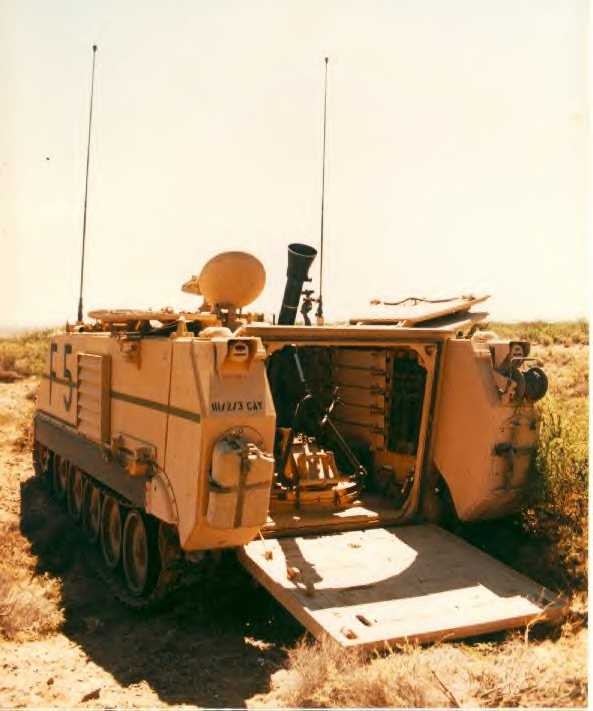
U.S. Army 120mm Mortars in combat in Afghanistan!
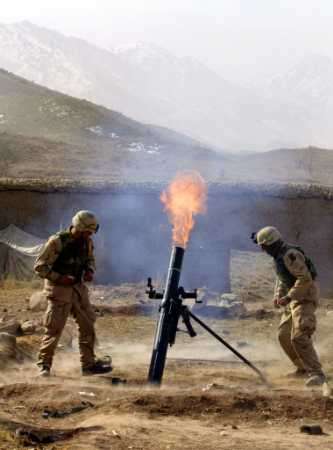
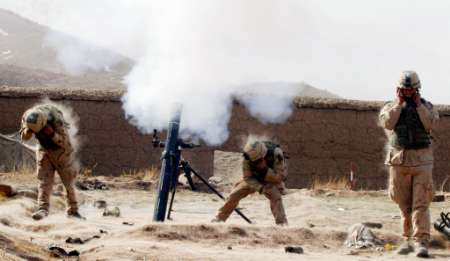
Swiss Army M113 Gavins with 120mm Heavy Mortars: Mountain Warfare Done Right
EXCLUSIVE! Hagglunds AMOS Twin 120mm automatic mortar system combatreform.org/amostwin120mmmortarsystem.wmv
 youtube.com/watch?v=-Y-j4KCNqKM
youtube.com/watch?v=-Y-j4KCNqKM
 youtube.com/v/TBqqWknHVqc
youtube.com/v/TBqqWknHVqc
BREAKING NEWS!
Light Infantry wants Guided 120mm Mortars--but needs LIGHT M113 Gavins to shoot them
Congress should order the Army's Light Infantry to adopt LIGHT M113 Gavin tracks as a permanent part of the new BCT MTOE and immediately dispatch some heavy unit M1064A3 Gavins and crews to Afghanistan for an immediate operational capability and to OJT the light unit mortar crews how to operate mounted mortars so when they get their Gavins they will be operational.
defensenews.com/story.php?i=3281882&c=FEA&s=SPE
Precision Mortar Has Fans, Not FundsBy Kris Osborn
Published: 17 September 2007
U.S. Army commanders are trying to resurrect funding for the canceled Precision Guided Mortar Munition (PGMM), a laser-guided 120mm mortar shell designed to hit one-meter targets from up to 10 kilometers away.
Future funding was terminated by Congress last December, after 10 years and roughly $100 million of development with several contractors. Nevertheless, ATK the primary developer since 2004, continues testing.
During a May 17 test at the Yuma Proving Ground, Ariz., shells hit an armored personnel carrier from 7 kilometers away, said officials with the company, based in Edina, Minn.
Lt. Col. John Lewis, product manager for mortar systems at the Army's Picatinny Arsenal, N.J., did not comment on the issue of funding for PGMM, but did praise the weapon's accuracy.
"PGMM will provide a great capability to the field," Lewis said.
Commanders in Afghanistan have written several times this year to request the munition.
In April, the commander of the 10th Mountain Division wrote to the commander of the Army Infantry Center at Fort Benning, Ga., to say that PGMM would help hit otherwise unreachable targets in populated, urban areas.
"Our recent military operations in both Afghanistan and Iraq underscore the immediate and significant need for an organic, responsive, precision strike indirect fire munition," Maj. Gen. Benjamin Freakley wrote in an April 2 letter.
"In the counterinsurgency fight, the PGMM provides the capability of delivering a relatively small amount of ordnance for precision engagements, limiting collateral damage. The 10th Mountain Division strongly supports the PGMM program and recommends an immediate restoration of funding."
U.S. light infantry units have had difficulty moving heavier mortar rounds through the mountains, Freakley wrote.
"Our recent experience in Afghanistan indicates that a precision-strike capability would also be extremely valuable when conducting combat operations at higher elevations, where maneuvering heavier fire support systems is difficult," he wrote.
Three months later, the commanding general of XVIII Airborne Corps sent an operational needs statement to Pentagon.
"This capability is critically needed within the next 12 months. As troop levels in theater begin to drop, our units cannot afford to miss opportunities to kill the enemy due to lack of organic precision indirect fire," Lt. Gen. Lloyd Austin III wrote in the July 17 statement.
And in August, the headquarters of the U.S. Combined Joint Task Force at the Bagram airfield in Afghanistan sent a second operational needs statement, asking the Army to buy and quickly field precision-guided munitions for the M119A2 105mm towed howitzer and 120mm mortar.
The rules of engagement in Afghanistan "limits the use of conventional artillery and mortar projectiles in support of combat operations," said the Aug. 17 statement, signed by Col. Mark Murray, Joint Fires and Effects coordinator.
For instance, enemy targets in Iraq and Afghanistan are often deliberately hiding in buildings and civilian areas, said one Army official in the Pentagon. A week later, Gen. Richard Cody, the Army vice chief of staff, wrote that the Army was considering the requests.
"If the Army determines that PGMM is the best system to meet this operational requirement, then we will seek to reinstate the program," Cody wrote in an Aug. 24 letter to Sen. Robert Byrd, D-W.Va., chairman of the Senate Appropriations Committee. *
E-mail: kosborn@defensenews.com
"Victory smiles upon those who anticipate the changes in the character of war, not upon those who wait to adapt themselves after they occur."
General Giulio Douhet, Command of the Air, 1921
1st Tactical Studies Group (Airborne) member, Emery E. Nelson writes:
"Several years ago when I watched the disaster unfold for the Rangers in Somalia I was unnerved to find out that they had no other support than helicopter gunships. I was sickened by the lack of understanding of those in charge. I'm not a "brain surgeon" but I can read. By reading press accounts of the war in Bosnia I was fascinated to learn that the Serbs preferred mortars To air support in built-up areas. The reasons are simple. Aircraft attack parallel to the ground. If they do this slowly they can be fairly accurate but then an aircraft costing millions of dollars is a pretty easy target. If they do this at a high rate of speed they are generally not very accurate and although harder to hit, still a target. On the other hand a 120mm mortar round is probably more accurate, Cheap, almost impossible to stop and it drops almost straight down. Picture yourself in a built up area. You are standing between two buildings. When attacked by a gun ship what are the chances of it firing on you? This probably seems elementary to you, but it wasn't to our military leadership in Somalia. I didn't know this because of my vast military experience. I knew this from reading about the Soviets in the second world war. This is one of the reasons the Russians love their Mortars. I remember a U.N. diplomat in Sarajevo saying that "the 120mm Mortar was the biggest killer in the city". Do you think the Rangers could have used those Mortars in Mogadishu?
When I read Carlton Meyer's web site on the 155mm Mortar I was pleased. Then I came to your site and it gave me more hope about the military then I've had in years. I didn't mean to write so much but it's a subject that's been a personal crusade for close to 20 years. I've written more letters than I can remember and bored all my friends and my long suffering wife forever. You can probably imagine how I felt when the Israeli's adopted both the 120 and the 160mm Mortars. I guess I just want to thank you for your positions and want you to know if you ever need my support to contact me.
With more gratitude then I can repay"
The problem of employing artillery to support rapidly advancing forces on a chaotic, increasingly urbanized battlefield remains a problem. Communications can be jammed and artillery systems are less mobile than manuever forces. As a result, the marine corps is considering adding 120mm mortars [still don't have any 6 years after this web page was first posted], and the U.S. Army which already has towed versions in the 75th Ranger Regiment and Self-Propelled (SP) 120mm mortars in M113A3 Gavin-type AFVs (M1064A3s) in its Heavy Infantry and Armored Divisions may include 120mm mortars in its Light Infantry Divisions (LIDs). The Rangers can employ 120mm mortars with 3-man teams and a HMMWV, so can other U.S. Army light units. U.S. Army 120mm mortars have been used in combat in Afghanistan as probably "temporary-loaners" to the 101st Air Assault/10th Mountain Division (see photos above) using its high-angle, 7 kilometer fires to great effect during Operation Anaconda. CH-47D Chinook helicopter air assault-delivered unarmored John Deere M-GATOR 4x2 ATVs are used to transport the heavy M120 mortar and its ammo up/down the mountains of Afghanistan. This is a much welcome beginning, but its not enough to meet he demands of future 4th Generation Warfare, asymmetric combats. Our men in Afghanistan need x-country mobile light tracked Armored Fighting Vehicles with 120mm mortars that have 64+ ready round under armor protection not subject to being exploded by a nearby enemy shell burst but Army politicians refuse to fly in the M113A3 Immediate Ready-Force Medium on strip alert at Ramstein AFB in Germany because media attention to the 17,000 M113 Gavin-type tracked armored fighting vehicles "kicking butt" in Afghanistan will spell the end for the un-needed, multi-billion-dollar, vulnerable, road-bound, rubber-tired LAV-III/IAV Stryker armored car purchase.
A good 1997 article by LT Brian Pederson in U.S. Army Infantry magazine describes how high-angle 120mm mortar fires from M113A3 Gavin-type AFVs are vital in mountainous areas:
Mortar Support in the Korean Defile
However, light forces do not have M113A3 Gavins or 120mm mortars.
Thus, U.S. light forces are in trouble.
This web page was originally an article for U.S. Army ARMOR magazine:
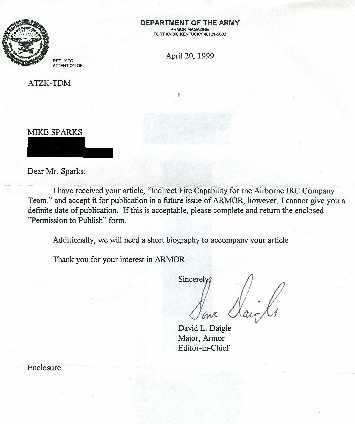
But as you can see over 10+ years later (!) they have not lived up to their promise to print it. The editor knowing he LIED to me felt so bad he sent me a challenge coin (see pic at bottom of this web page). Anything that is not pro-Stryker truck bullshit (BS) doesn't get printed in ARMOR magazine, which should be renamed ARMORLESS magazine. What a bunch of fucktard brown-nosers!--as the debacle in Afghanistan continues where the light infantry now is crying for 120mm mortars--which has proven we were right all along--and why the Army is a BUREAUCRACY of yes-men: not a PROFESSION that admits to problems and THINKS AHEAD to solve them.
The tragedy here is that if ARMOR magazine had printed this article in 1999 as they promised, maybe the Army would have got some M1064A3 Gavin tracks with 120mm mortars and been READY two years later in Afghanistan to maneuver and strike deep to get Bin Laden and subordinates. Instead, we fumbled around without ANY tracked maneuver or artillery and foot-slogged at Tora Bora and Operation ANACONDA resulting in the enemy getting away and plotting as we speak to do another 9/11 attack on America.
Is it a wonder that Armor Center is moving to Fort Benning to be gobbled up into the "Borg" of the light infantry narcissists and have no room to maneuver on a post covered in trees? Armor branch can only blame itself for being well on the road to extinction for not fighting the Stryker truck madness in its now gutless magazine. The problem is, that America cannot exist without a force that uses tracked armored fighting vehicles skillfully and for 2D and 3D maneuver. Maybe its time to start over with a new unit designed for non-linear warfare based on an adult military culture?
We can deploy now by air within hours to any spot in the world to meet a crisis and the heaviest weapons we'll have will be some towed 105mm howitzers (if we are not snobby and egotistical and decide 'we are infantry and we do not need inferior life-form cannon cockers helping us' re: Afghanistan hubris) and machine guns mounted on HMMWVs. The likelihood we'll be out-gunned by the enemy on the next battlefield since we are now without an air-deployable Armored Fighting Vehicle (M8 Armored Gun System cancelled and M551 Sheridans sent to NTC to play war games), M728 Combat Engineer Vehicle (CEV) scrapped, 90mm recoilless rifles retired, Iowa-class battleships back in mothballs or being turned into museums, is great. In Vietnam, if the enemy could get "belt-buckle" close, we couldn't use our distantly emplaced artillery and air strikes out of fear of hitting our own men. Thus, in-close the ENEMY dominated us with RPGs and rifle grenades with superior explosive effects, pinning us down and creating bleeding casualties in our ranks. We still have not solved the close-range firepower inadequacy of U.S. infantry. The 60mm mortar is a bust.
U.S. forces DO NOT have rifle grenades and rely on the M224 60mm mortar at company level without fire direction; an exercise in futility on the battlefield. Too heavy to be carried swiftly to various parts of the battlefield like the "knee mortar", its 60mm projectile is too wimpy to control the terrain with explosive effect from a static position without a Fire Direction Center (FDC) and is ineffective against buildings in MOUT. In Vietnam, the enemy ran circles around our units humping the 60mm mortar, pummeling them when they stopped to rest. If they had rifle grenades they could have stopped this immediately.
http://www.earlyamericanhomes.com/Vietnam/articles/1997/04972_text.htm
A noted weapons analyst describes how this could be dealt with:
"The 60mm mortar is an order of magnitude larger than the 40-50mm mortars (actually "grenade launchers") I was writing about.
No, I would not recommend the 60mm mortar for a hunter-killer team. Wrong size. Weapons at each echelon should be matched.
Squad weapons (rifles, SAWs, and rifle grenades) reach out several hundred meters, essentially in direct-fire. Shooters are often pinned and can barely get a fleeting glance at the targets.
Platoon weapons (Light/Medium Machine Guns, recoilless rifles, etc) need greater range (about 500-1,000 meters) to overwatch all of the squads. By being farther back, they cover the platoon front and also draw less suppressive fire. They are still rapidly emplaced and frequently shifted, so are also direct fire, only.
Company weapons (tripod-mounted .50 cal Heavy Machine Guns, mortars, heavy recoilless rifles) have still greater range (well over 1,000 meters, and 3,000 meters becoming the norm once TOW fielded) to overwatch all of the platoons. They are far enough back to where they can set up a stable firing position, hence this is where indirect firing mortars first appear. They also require large crews to handle the ammunition, observing and fire control, etc., so they do not belong in the front lines.
Placing heavier weapons farther forward generally doesn't work. They are too readily suppressed, the crews are too exposed, and the commander loses control. In WWI, we tried pushing French 75s along with the assault elements to take out machinegun nests. Germans tried same sort of thing at times. Both sides just got the guns stuck in mud and lost the crews to the very same machineguns they sought to kill.
The 60mm mortar is too cumbersome for platoons, and too light for companies. Its bursting charge is too small to be effective, and its range is mediocre. Peacetime 'Light fighters' prefer it to the 81mm because they can carry it easily, but combat experience (WW II, Korea, Vietnam) always resulted in replacement by the heavier mortar for a few years, until peacetime preferences took over, again.
Regards the article on Vietnam, you see the problem throughout. Mortar crew too small to carry enough ammo, so everyone else has to carry rounds. Crew constantly being suppressed. Ammo quickly expended. Accuracy and effectiveness doubtful. Compare to what could have been instead with a company 81mm platoon and battalion 4.2" mortar platoons in direct support, reacting to calls for fire from the lead platoons. A lot easier and more effective, assuming that you have guys trained as FOs. But hey, that war is long over and I do not need to refight it. Just remember that there are plenty of lessons from it, and most are, 'don't do what we did.'
To do 'hunter-killer' today, squads would suppress and leader should simply call-for-fire.
Digression: During early 1980s, concurrent with GEN Wickam's 10,000 man Light Infantry Division (LID), we went off to replace the company 81mm and battalion 4.2" mortar with the 'new and improved' 60mm and 81mm, respectively. They claimed that new projectiles were so much more lethal that we could 'do more with less.' Well, to make a long story short, Light Fighters still have the 60mm, the heavy fighters scrapped the 81mm altogether and went up to 120mm mortars at battalion. What does that tell you?
It was after I learned more on rifle grenades that I came to appreciate the value of the 40-50mm mortars that were common at the outbreak of WW II (Germans, Poles, Russians, Japanese, others). Their role was an extension of WW I anti-machinegun 'hunter-killer' teams. The French merged a Chauchat automatic rifle team with VB rifle Grenadiers into a squad for taking out German Maxim 08/15 light (okay, 60 lbs, but still portable) machineguns. The Chauchat would suppress while VBs were fired and adjusted until the target was killed. In such a role, a 40-50mm mortar is much more stable and accurate than a grenade launcher. Of course, trench warfare did not set in in WW II, so the small mortars disappeared over time. Still, they were far more useful in a defense than most people realize."
Thus, U.S. Commanders and policy makers are reluctant to get into conflicts where they may be close-range fighting against an enemy who "hugs" us. A U.S. "black eye"; (a conflict where we take over 4 digits in deaths) translates into the loss of U.S. support for the war at home, a political surrender and withdrawal and ventually the super-power status and a world turning to darkness and intimidation instead of the rule of law. Tet 1968 all over again, and AGAIN until we learn a solution for it. THE SITUATION IS THAT CRITICAL. The solution is a PROFESSIONAL ARMY that studies war, faces the problems courageously and arrives at SPEEDY solutions. Here is one.
FORCED-ENTRY AFV 120mm MORTARS FOR THE AIRBORNE
The verdict is in on the Immediate Ready Company (IRC) that airlands by USAF cargo aircraft (C-17) to provide 70-ton Abrams Main Battle Tank, and 33-ton Bradley infantry fighting vehicle Armored Fighting Vehicle (AFV) fire support for the XVIII Airborne Corps and its 82nd Airborne Division when its M551 Sheridan and M8 Armored Gun System light tanks were taken away or not supplied as promised. The official report on the use of unimproved runways proves that extensive and continuous engineer repairs are needed to enable the IRC to airland.
http://www.wood.army.mil/CELL/LESSONS/sba-saaf~min.doc
- P-hour is first airdrop aircraft time over target.
- P+30 minutes is last echelon A aircraft airdrops load.
- P+4 hours is first echelon B aircraft lands at target area.
- P+24 hours is last echelon B aircraft lands at target area.
This tactical/operational liability has placed the XVIII Airborne Corps into a potentially disastrous situation of BEING REQUIRED to seize a long concrete runway from an alert and dug-in enemy. The dangers of this predictable "airfield seizure" tactic are described in detail in Major (now COL) Michael Kazmierski's U.S. Army Command and General Staff college 1991 master's thesis which can be read online here:
www.reocities.com/Pentagon/Quarters/2116/airbornetoc.htm
Current events bear this out. The recent Airborne deployment of XVIII Airborne Corps Paratroopers to create a firebase for the tracked M270 Multiple Launch Rocket System (MLRS) and AH-64 Apache attack helicopters to Albania to attack the Serbs in Kosovo is a superb example of Airborne warfare--deploying rapidly by AIR within hours/days and sustaining this lethal force deep inland. However, this Airborne deployment also showcases the pitfalls of having to AIRLAND heavy vehicles like the MLRS and Bradley Fighting Vehicles (BFVs); bad weather preventing USAF C-17 Globemaster IIIs from landing thus creating delays that made world headlines.

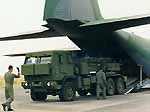
EXCLUSIVE! HIMARS 227mm rocket system video www.combatreform.org/himars.mpg
A better Airborne force structure with LIGHT Armored Fighting Vehicles (AFVs) like the enhanced M113A3 Gavin-based family of vehicles and the new FMTV 5-ton truck-mounted MLRS called HIMARS that could be C-130 transported and AIRDROPPED regardless of suitable weather to airland could achieve the same operational capabilities in a faster time. Even better than a vulnerable wheeled HIMARS would be one based on a XM1108 M113 Gavin tracked armored variant that LTC Larry Altersitz describes in his web pages below:
The M1064A3 120mm long-range heavy mortar system arguably would be a more versatile and lethal airbase defense weapon than the direct-fire weaponry of the BFVs because its indirect fires can reach farther (7 kms vs 2 km) and into dead space areas in the mountainous terrain of Albania that the 25mm chain gun and 7.62mm co-ax Medium Machine Gun would require a direct line-of-sight. 505th Parachute Infantry Regiment Paratroopers on patrol could call in and adjust 120mm heavy mortar fire onto any lurking Serbs thinking of challenging the firebase's security. Certainly there is nothing stopping the deployment of XVIII Airborne Corps 3rd Infantry Division "Rock of the Marne" 120mm AFV mortar systems to bolster the airbase capabilities right now--5 x M1064A3 120mm mortar systems can fit inside one C-17! BOTH BFVs and M1064A3 120mm mortars is an even better force structure.
However, the Engineer report on maintaining unimproved runways concludes using faulty logic that the only solution to the problem is to maintain the status quo and re-arrange the wording of some requirements documents to lower expectations. This is a bureaucratician's* way of avoiding the problem and coming up with a SOLUTION. The problem is the IRC needs to be airlanded because we do not have an AIRDROPPABLE AFV unit in the XVIII Airborne Corps after the Sheridans/Buford AGS were taken away/not supplied.
What the Engineer report should send to us is the CLEAR message that the airland-only IRC is a tactical failure if it forces the Airborne into an enemy ambush, and runway-dependancy and we need to change it. If alive today, the U.S. Army's Airborne warfare pioneers, Gavin, Ridgway, Lee and the thousands of men who died jumping into battle would be aghast at how our current uninspired predictable thinking has marginalized what they fought for with their lives to obtain as a force deployment capability for the free world. This is our "mission analysis" and the result should be a different Course Of Action (COA) than the status quo of dropping directly into the kill zones of enemy weapons on the heavily defended airfield in order to provide a paved runway for airlanding for risk-averse logisticans. Better this "learning curve" than flag-draped coffins with dead American Paratroopers inside.
AIRDROP SEGMENT OF THE IRC
The IRC is composed of elements of the 3rd Brigade of the 3rd Infantry Division ("Rock of the Marne", "Audie Murphy" Division ) based at Fort Benning, Georgia, which is part of the XVIII Airborne Corps. This force not only has M1 Abrams main battle tanks and M2 Bradley Fighting Vehicles, it has 11-ton M113A3 Gavin AFVs which are easy to AIRDROP from any large USAF cargo plane (C-130, C-141B, C-5, C-17) and thus, can be inserted with the "A" echelon that parachutes in with the first wave of aircraft to provide shock action for our Paratroopers. This way, the brave Paratroopers of the 82nd Airborne will have armored vehicle fire support and shock action from the drop zone within minutes not 4 hours later too late after a bloody fight.
The 3rd Brigade has modified M113A3s called M1064A3s that fire the awesome 120mm heavy mortar from the top roof hatch. A Company of 3rd BDE Soldiers and their 120mm mortar M1064A3s should be placed on jump-status, with a platoon always ready to airdrop with the first echelon of the 82nd Airborne's Division Ready Force (DRF). 1-507th PIR Airborne school is co-located at Fort Benning with the designated 3rd BDE mortar company, so in 3 weeks an entire company of volunteers could become Airborne qualified without TDY/travel costs to the Army. Fort Benning's Riggers are light personnel pack parachute capable, but there is a U.S. Army Reserve 421st Rigger company in nearby Fort Valley, Georgia that can do heavy drop rigging that can be assigned the task of rigging the IRC's airdrop mortar platoon's M1064A3's.

FORCED-ENTRY 120mm MORTAR FIREPOWER FOR THE AIRBORNE
 youtube.com/watch?v=50cpPAVoxJQ
youtube.com/watch?v=50cpPAVoxJQ
As Stan Crist points out in his superb article in Army magazine in July 1997, the M113A3 mobile-120mm mortar is devastatingly effective in open terrain combat and can fire a wide array of guided mortar projectiles that can kill enemy tanks 7 kilometers away long before they can even get within main gun range. He proves that an airlanded planeload of Airborne crews with M113A3s (8 in a C-5 with 73 men in upper deck seats or 5 x M113A3s and 54 men in a C-17) is a better use of airlift assets than just filling aircraft with infantry since the AFV-mobile Paratroopers can carry plenty of water/food/ammo for a week of desert operations onboard their vehicles whereas a foot-mobile Soldier would be hard pressed to carry even a day's worth of water in his rucksack, let alone ammo or food. His proposal for a M113A3 Gavin Brigade to replace the loss of the 3rd/73rd Armor Battalion is reasonable and should done NOW by providing the new 2nd ACR "Strike Force" at Fort Polk, LA with M113A3s for an immediate operational capability. M113A3s are superb platforms for the soft-launch of forward-looking infared guided Javelin ATGMS as well as dismounting Airborne infantry armor killing teams. LTC Richard Hooker calls for a 42 scout vehicle Battalion in his "Light Division 2010" proposal described in the March 1999 issue of Armed Forces Journal International. These vehicles should be M113A3 Gavins so the Airborne/Light Infantry Brigade Commander (Colonel Douglas MacGregor's Breaking the Phalanx model of self-contained Regimental-sized combat teams) can mount a large portion of his Airborne infantry to move at high-tracked vehicle speeds (10-40 mph) under armor and not just the 1 mph foot-slog. Major Charles Jarnot ("AIRmechstrike: revolution in warfare", Military Review, April 1997) advocates a stealthy compound heavy-lift helicopter to replace the CH-47D Chinook that could lift the current M113A3 Gavin-family of vehicles and their Future Combat System (FCS) replacement to create an AIRmechanized capability to fly over/around enemy obstacle, resistance to achieve decisive maneuver. His web page with illustrations of this:
reocities.com/Pentagon/Quarters/2116/airmechanized.htm
Certainly, compared to the changes needed to propel Army Light forces into the Army After Next, to designate a mechanized mortar company already fully equipped and trained as a part of the XVIII Airborne Corps an "Airdrop IRC mortar company", providing additional on-post training and some airdrop Rigger support is not asking for a drastic change or one requiring large costs.
A trio of C-17s can Low-Velocity AirDrop (LVAD) the DRF Airborne mortar platoon Paratroopers and their M1064A3s, which can after de-rigging rumble cross country from an off-set drop zone and "hip-shoot" at enemy targets to free the Airborne infantry to advance on the enemy airfield from an unexpected direction. Instead of being dependant upon unreliable aircraft for fire support (CAS) which is likely to be unavailable due to time/distance/weather factors, the Airborne would have its own "Ground Spectre" capability with the 120mm mortar firing from the back roof and .50 caliber Heavy Machine Guns (HMGs) and/or MK-19mm Grenade Machine Guns (GMGs) firing from the M1064A3 Track Commander's hatch cupola mount. Ground-level fire support in an armored platform resilient to enemy small arms fire will "be there" when the enemy must be killed/suppressed. One of the weaknesses of the current Abrams/Bradley Company Team is neither vehicles have indirect trajectory weapons.
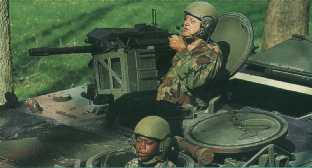
The M1064A3 as a part of the Company Team with 120mm mortars and MK-19 40mm GMGs solves this problem. The 120mm mortar and Mk-19 40mm are proven in combat against urban targets in a rapidly urbanizing world because they fire with an indirect trajectory to avoid target masking and have in the case of the 120mm a large warhead with delayed fuze blast effect to penetrate/kill the enemy deep inside buildings. 81mm and 60mm mortars are ineffective in urban combat against enemies in multi-storied buildings that are strongly constructed with brick, concrete and steel. Most international airports are ringed with urban structures that will require 120mm and 40mm GMG fire followed by infantry assaults in order to clear out the enemy for safe airlanding operations.
The cost to the Army of this tasking would only be the funds required to move the airdrop materials to the Fort Benning Lawson Army Air Field site, and the recovery costs of an annual FTX heavy drop with a slice of the 82nd Airborne Division at Fort Benning or at Fort Bragg, NC. The Russian Airborne already has an armored, tracked 120mm gun-mortar in a TURRET that is air-droppable for its Airborne Divisions: the 2S9 Nona, depicted below:
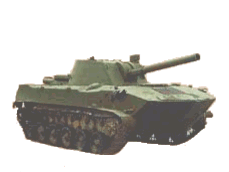
*Bureaucratician: A clever with data, lazy person who ignores your factual points then finds a flimsy excuse (ANY excuse--usually a quibble over a minor detail) divorced from the real world in order to do nothing and maintain the status quo even though it continuously brings disaster. Failure in combat is "ok" with the bureaucratician since he's not the one who is getting maimed or killed and he can always use excuses like "the politicians were the blame" or someone else in DOD "didn't do their job". A narrow-minded, linear thinker who cannot see "the big picture"--- who cannot anticipate a clever enemy's asymmetric battle approach to defeating our efforts. Afraid to "rock the boat" and risk his job security, all previous assumptions and actions from higher headquarters are "written in stone" and "sacred cows" even if a mere report of a necessary modification would be received and rapidly implemented by often receptive Commanders. In short, an enemy to progress and U.S. Army victory in combat by his selfish timidity.
Fortunately, you, the reader can contact the mortar systems managers and senior leaders of the U.S. Army who are in a position to help save the day IF... we can get heavy 120mm mortars and 81mm mortars into the battlefield with our Paratroops of the 82nd Airborne Division so they can provide themselves some critical fire support in a world rapidly urbanizing. The "enemy" is going to be in a BUILDING (today's reality) not just a sophisticated armored vehicle (Cold War paradigm); 60mm mortars will not bust bunkers or buildings as the Israelis learned in Lebanon in 1982. It took an entire platoon of British light infantry to manpack TWO 81mm mortars and 50 units of fire in the Falklands; we must break both "paradigms" to make mortars work for us.
TOWED MORTARS FOR THE 82nd AIRBORNE DIVISION, YES
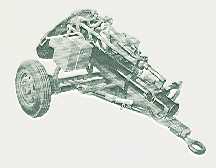
1. Replace 81mm mortars in the 82nd Airborne's Infantry Battalions with current M120 120mm mortars since you need a HMMWV 4 x 4 vehicle to carry 81mm ammo, so why not 120mm? For airdrop, use a M-353 Trailer to carry 120mm ammo AND the M120mm mortar so we get 2 X 120mm mortars per C-130 load, don't waste aircraft space and time wheeling the M120 around on a M1100 trailer that carries no ammo. Test my suggested max-capacity HMMWV mobile 120mm mortar airdrop for the C-130 Hercules. Or better yet, buy a "Micro-HMMWV", a small Dragoon force on ATVs like the John Deere ParaGator or Polaris ATVs to move 120mm mortars into position. The German Airborne used to do this with its KRAKA 4x4 ATVs until replaced by the tracked, armored Wiesel.
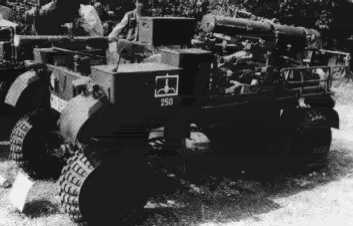
Notice the 120mm mortar carrier KraKa? Right now our Airborne forces have a few batteriess of 105mms/155mms which are more or less "Alamo" systems (wait for counter battery radar's to get a location, and them fight to the last man,,,, or surrender). Although there is nothing wrong with this in certain situations, In WWII and Korea, these systems were overrun and captured (and then turned against us) when our enemies went on the offensive.
An Airborne or Air Assault unit performing a deep strike mission would find itself without many fire support systems in their present configurations, and the systems they do possess would have the limitations of being towed. I have read doctrinal statements to the effect that our Air Assault and Airborne forces will have the benefit of many air attack systems like the Apache and AF Close Air Support (CAS). For many reasons I believe this is a fantasy that would put "Alice in Wonderland" to shame. Just to name a few, the Apache has limited range and can't operate very effectively over enemy territory during the day. With our enemies seeing the need for night vision devices even the night is going to get tricky for the Apache. The second problem is AF, CAS.
With the exception of the A-10 the AF has no real systems that can provide CAS. The AF is very busy trying to get rid of the A-10 as I write this so even that is a questionable system. The AF concern is Strategic and not tactical. All lip service given to CAS is to keep the Army from taking it away (If anyone believes different, read the GAO report on Air Power In the Gulf, Into the Storm, and all the articles about the recent AF dollar wasting exercise in Kosovo).
My third reason for believing that these systems won't work, trumps the other two. The COST of these systems will not allow them to be used in an actual war. Although the AF 5,000 ceiling is very good for preserving these expensive systems (just for now, since every country in the world is working on an ADA system above that.) This makes them very ineffective (and dangerous to those they are supporting) at CAS. General Officer Mindset (GOM) will prevent Apaches from being deployed in anything other than training because they've put lots of their "eggs" (money) in the Apache "basket" and will go to great lengths to protect them from the implications of their destruction.
Our point here is the 120mm mortar mounted on a light weight, air transportable vehicle is the perfect solution to many of these problems. It will give Airborne and Air Mobile units their own internal fire support systems, with many capabilities that are as good and in many cases better than CAS. The 120 has good AT rounds
reocities.com/Pentagon/Quarters/6747/smartmortars.htm
and can do pretty well against fortifications. It's the near perfect solution for a unit working in a deep strike capacity. With communication jamming systems getting better all the time, I think it's safe to say that any commander would rather have something organic to his unit than a promise of support from "beyond".
In the latest from Hack's Defending America newsletter, someone defending the F-22 (dollar) Rupture mentioned that those who didn't want to support the plane wanted to go back to the P-51. In the Germans own view, the lowly P-47 won the war for us. I have talked to to many infantrymen who loved the A-1 (prop driven) in Vietnam more than any other form of CAS. Slow and low equals good CAS.
Replace the 60mm mortars in the Infantry Companies with 81mm mortars since they are ineffective for their weight. Store for use in low-intensity conflicts in extreme terrains. By upgrading to 81mm/120mm from 60mm/81mm we need no additional manpower if we use the following mobility devices.
2. Make 120mm M120 mortar door bundle airdrop an option by getting the USAF to ease up on the 66" height requirement for door bundles: 72" on a 120mm mortar tube is the same as 6 feet tall Paratroopers who jump out of C-130s all the time, why not a bundle? Make the lightweight composite mortar tube's ball that fits into the base plate socket detach if you need to reduce 6" to meet the 66" USAF door bundle requirement. Use a piece of truck bed liner (or SKEDCO) plastic so the bundle has directional ribs so it will slide forward and out the jump door and not back against the trail edge when it hits the relative wind.
Use door bundles to also deliver M252 81mm mortars. Have each Paratrooper in the infantry company carry 1 x 81mm mortar round in his rucksack instead of the 60mm mortar round and have them drop-off their rounds at the assembly area off the drop zone if mortar ammo is not mobile loaded on HMMWVs or an All-Terrain All-Purpose Cart/Sled (ATACS).
3. Make 120mm mortars manpack possible and the 81mm mortar man-portable with less exertion by;
* Developing a padded double-sling with quick-release sternum strap so the mortar tube is carried "backpack" style high above the rear legs for better load distribution and unimpeded mobility. Make the straps long enough so it can be draped over the rucksack as worn. The straps together are a conventional single-sling across the back for those that prefer it.
* Develop a curved heat-resistant material pad(s) that slips over the mortar tube that fits over the shoulder like a bicycle carry pad so one Soldier can balance carry the tube with one arm on the tube or two Soldiers fore and aft of the tube.
* Purchase the UT 2000 backpack/all-terrain all-purpose cart/sled system so 120mm heavy mortars can be towed by a firing section with ammunition in terrain unpassable by HMMWVs or emergency if HMMWVs are destroyed by enemy action, bad airdrop etc. UT 2000 all-terrain wheels can be attached at the cart body at the point where the load balances so the Soldier towing it hands-free by a harness doesn't have to lift the load at the front. The UT 2000 separates into two load carry backpacks for areas where towing cannot continue or airdrop/airland. A helicopter heavy mortar raid could take place with the rear ramp of a CH-47D Chinook being lowered and a UT 2000 with 120mm mortar and crew rolling out to a nearby firing point.
The UT 2000 ATACS can shuttle out wounded Soldiers and bring forward ammunition.
The UT 2000 ATACS is distributed by FERNO:
NSN: 6530-01-398-3949
Part number: 42-000
Price $759
Ferno MILITARY PRODUCTS
70 Weil Way
Wilmington, Ohio 45177
Phone: (618) 651-9205
FAX: 9086
E-mail: mharris@ferno.com
...and is in use by the Austrian Army, U.S. Army Airborne, Special Forces and McMountain Warfare School.
4. Get at least a Company of 16 x M1064A3 (M113A3) Gavin APC mounted mortars in the 82nd Airborne and assign one battalion's mortar section on Division Ready Force-1 (DRF-1) status to be ready to parachute in and heavy airdrop a 4-vehicle M121s section in case of 18-hour emergency deployment. These M121s could also be used as expedient Armored Personnel Carriers to overcome enemy direct fire by strapping the M120 mortar to the vehicle outside and/or detaching the 11C Soldiers who fire the heavy mortars at a firing point so the M121s can move forward by the driver with 11B Paratroopers inside and M2 .50 caliber or 40mm MK-19 Grenade Machine Guns firing by the Track Commander. I'm sorry about this "round about" way of getting the 82nd Airborne an APC, but they need one nevertheless since they can't hop on the back of the now disbanded 3/73rd Armor Battalion's M551 Sheridans anymore. Without an APC on the ground on the drop zone at H-Hour, the Airborne will be unable to advance forward against enemy fire without heavy casualties. Why we must relearn this lesson every time we fight a war? If the 82d Airborne loses, we all lose.
5. Make the inclusion of a 120mm mortar platoon in M1064A3s a standard "slice" that the heavy "Company Team" has. This needs to be a habitual task organization since the Company Team doesn't have a weapon to fire indirectly at enemies hiding in dead spaces or on building rooftops. The Abrams/Bradley Fighting Vehicle (BFV) Airland Immediate Ready Company assigned to the XVIII Airborne Corps on alert status needs to be beefed up with a 120mm tracked mortar platoon. The entire mortar platoon can fit inside one C-17 Globemaster III aircraft.
6. Insure an artillery counter-battery radar can be airdropped with the 120mm mortars so they and the M119 105mm towed howitzers can silence enemy artillery so the bad guys cannot close down the airhead ala Dien Bien Phu in 1954. Replace the M119 105mm with a lightweight 155mm howitzer as soon as humanly possible to include an emergency initial operational capability by buying at least one 8-gun battery NOW for use by the 319th FA of the 82nd Airborne Division. In a North Korean-invasion scenario, enemy artillery would be landing all over and must be silenced by--- if necessary precision guided munitions from mortars and artillery tubes if USAF TAC AIR is not up to the task, which is highly likely since they were not able to find and destroy mobile SCUD missiles in the open desert in the Gulf War.
7. Insure mortar crews and all PARATROOPS can dig-in with the new FPOC overhead cover to hold the airhead; the mortar crews can up-turn their UT 2000 ATACS backpack frames and use them as roofs for overhead covers from enemy artillery fire. FPOC roof pieces need to be mass procured and be dropped along with Paratroops to protect them from enemy fire.
8. Field the PGMM, XM395 Precision Guided Mortar Munition as soon as possible so the 120mm mortar crews can engage and destroy enemy armored vehicles with top-down attack.
THEN, with the situation stabilized, the 82nd Airborne Division can then move out from the airhead with high mobility in M1064A3 (M113A3 with M121s) for shock action and impromptu armored troop transport, and responsive fire support with adequate "punch" to prevail in cities and destroy any enemy armored formation maneuvering on it and/or silence any artillery seeking to pin it down in the airhead. The 82nd Airborne can move forward with its mortars by manpack, towing or vehicle transport.
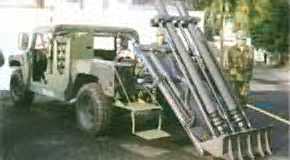
The Republic Of China (ROC) Army on Taiwan has an unique 120mm mobile mortar system mounted on the M998 HMMWV 4x4 without modification to the carrier vehicle. A small gas generator is used to power the hydraulic deployment and retraction system for the double barrel XT-86 mortars. The system can be elevated up to 75 degrees, have a rate of fire up to 20 rounds per minute, a maximum range of 6 miles, and provisions to carry 15 standard rounds. The entire system can be operated by a crew of three, assisted by a GPS-based fire direction computer.
9. Replace the M120 120mm and M252 81mm mortars with lightweight components as soon as possible to include a 120mm mortar HMMWV mobile launch capability as depicted in the Picatinny Arsenal Mortar Book. The Republican of China (Taiwan) ALREADY HAS a TWIN 120mm mortar!
10. Upgrade M1064A3 (M121/M113A3) 120mm mortar carriers with turreted gun-mortar systems for faster fire/move capability; insure it is low enough to be airdroppable from C-17 Globemaster III aircraft. Insure turreted 120mm gun-mortars can be used in direct-fire mode to destroy buildings, bunkers, other Armored vehicles as they are encountered on the fast-moving battlefield. This is vital with the retirement of the M551 Sheridan light tanks and cancellation of the M8 Armored Gun Systems to replace them.
11. Buy 120mm mortar Wiesel or BV206S (M973A2 armored SUSV) ultra-light or modify M113s into "Mini-Gavin" AFVs for the 101st Air Assault Division to give fire support for other Wiesels in an Air-Mechanized capable "Screaming Eagle" Division.
12. Buy ParaGator 2 x 4 ATVs to transport 81mm and 120mm mortars in the 82nd Airborne to get 3 per C-130 airdrop instead of just 2 x HMMWVs. [Update 2002: this is being done now in Afghanistan by U.S. Army forces]
13. Develope rifled 155mm mortars that can fire 155mm howitzer projectiles to enable these advanced projectiles to be utilized by the infantry as well as simplify logistics.
HISTORY PROVES OUR POINTS: U.S. ARMY RESCUE OF marines AT KHE SANH
Emery Nelson writes:
"The 1st Cav took the credit for opening the road but it was actually done by elements of the 11th ACR and some Armored Cav Bns attached to the 1st Cav. Of course the Mc and 1st Cav took all the credit. I served with many of the men who participated in that operation and they were very proud of it. That as one of the few times they got a chance to do their jobs and they loved it. They made hooks into the surrounding jungle and would pop up a klink down the road and the engineers would work the area in between. That was where I first heard of using mortars in mobile operations. One of my Recon Plt leaders was a Troop Commander there and he used three 4.2 inch heavy mortars (saw the pictures)
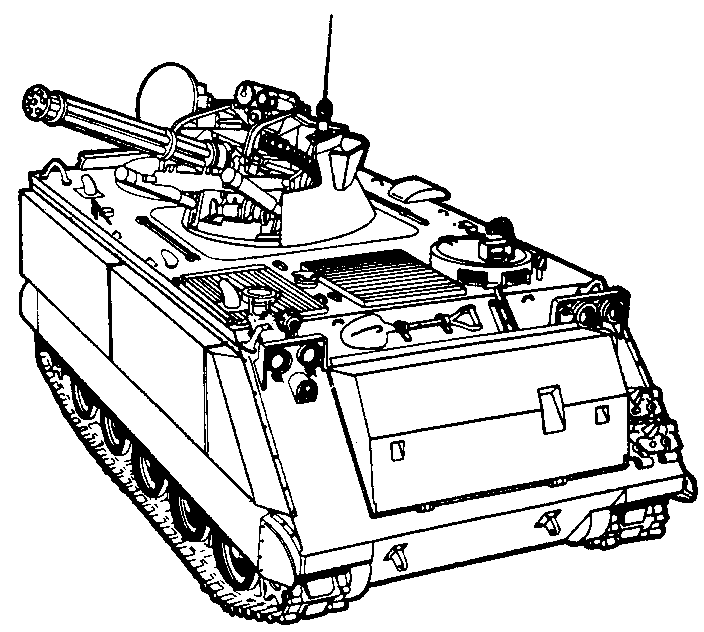
...and a lead element of M113 mounted Vulcan 20mm miniguns (saw the pictures) to fix ambushing NVA. Then -113s and Sheridans would crash into the jungle and attack them from behind. The NVA were not able to deal with that and they kept up the pressure (means go fast) until they reached what the official Mc history called a 'link up from the Khe Sanh side'. The Story I heard was they linked up about a mile and a half outside the main gate and that was only because the Cav units were ordered to halt and wait for the marines. This was supposedly to prevent a friendly fire accident but some people believe different.
One of the unusual things about this operation is the desperation to relieve the marines was so great the AC units were allowed for one of the first times to fight as they saw fit. Up until that time an ambushed Cav unit would turn online and make a frontal attack into the ambush. The NVA would mine the front of their positions and dig in deep. The result would be the tracks hitting mines and being destroyed by RPGs. They would use air burst from the mortars in front of the Ambush to destroy mines. Not always successful but definitely helpful."
AIRBORNE!
Here's the Challenge Coin, Armor magazine's editor sent me after he reneged on his promise to print this article....what will we give the DEAD and MUTILATED Soldiers who needed TRACKED TANK MOBILE 120MM MORTARS?
Maybe the coin will be worth a lot money once Armor branch becomes a thing of the past due to it's own bureaucratic stupidity?
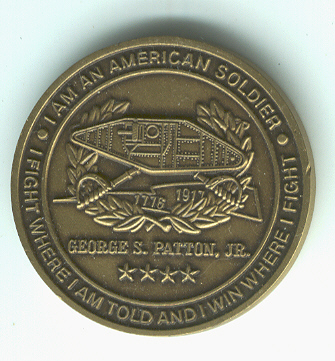
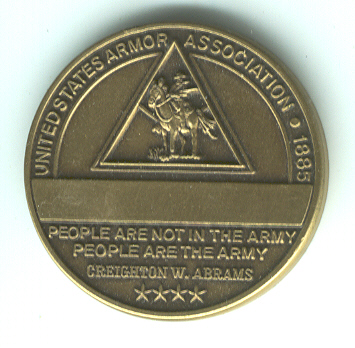
RETURN TO U.S. ARMY AIRBORNE EQUIPMENT SHOP